
30 October-1 November 2025




30 October-1 November 2025


Thursday 30 October, 7.30pm The Queen's Hall, Edinburgh
Friday 31 October, 7.30pm City Halls, Glasgow
Saturday 1 November, 7.30pm Aberdeen Music Hall
MOZART Piano Concerto No.21 in C K467
Introduction to Webern's Symphony by Andrew Manze
WEBERN Symphony
Interval of 20 minutes
MOZART Piano Concerto No.24 in C minor K491
Andrew Manze conductor
Yeol Eum Son piano



THANK YOU
Our Principal Conductor’s Circle are a special part of our musical family. Their commitment and generosity benefit us all – musicians, audiences and creative learning participants alike.
Annual Fund
James and Patricia Cook
Visiting Artists Fund
Harry and Carol Nimmo
Anne and Matthew Richards
International Touring Fund
Gavin and Kate Gemmell
Creative Learning Fund
Sabine and Brian Thomson
Conductor Emeritus Joseph Swensen
Donald and Louise MacDonald
Chorus Director Gregory Batsleer
Anne McFarlane
Principal Second Violin
Marcus Barcham Stevens
Jo and Alison Elliot
Second Violin Rachel Smith
J Douglas Home
Principal Viola Max Mandel
Ken Barker and Martha Vail Barker
Viola Brian Schiele
Christine Lessels
Viola Steve King
Sir Ewan and Lady Brown
Principal Cello Philip Higham
The Thomas Family
Sub-Principal Cello Su-a Lee
Ronald and Stella Bowie
Cello Donald Gillan
Professor Sue Lightman
American Development Fund
Erik Lars Hansen and Vanessa C L Chang
Productions Fund
Anne, Tom and Natalie Usher
Bill and Celia Carman
Scottish Touring Fund
Eriadne and George Mackintosh
Claire and Anthony Tait
Cello Eric de Wit
Jasmine Macquaker Charitable Fund
Principal Flute André Cebrián
Claire and Mark Urquhart
Principal Oboe
The Hedley Gordon Wright Charitable Trust
Sub-Principal Oboe Katherine Bryer
Ulrike and Mark Wilson
Principal Clarinet Maximiliano Martín
Stuart and Alison Paul
Principal Bassoon Cerys Ambrose-Evans
Claire and Anthony Tait
Sub-Principal Bassoon Alison Green
George Rubienski
Principal Horn Kenneth Henderson
Caroline Hahn and Richard Neville-Towle
Principal Timpani Louise Lewis Goodwin
Geoff and Mary Ball




Diamond
The Cockaigne Fund
Malcolm and Avril Gourlay
John and Jane Griffiths
James and Felicity Ivory
George Ritchie
Tom and Natalie Usher
Platinum
E.C. Benton
Michael and Simone Bird
Silvia and Andrew Brown
David Caldwell in memory of Ann
Dr Peter Williamson and Ms Margaret Duffy
Judith and David Halkerston
David and Elizabeth Hudson
Helen B Jackson
Dr and Mrs Peter Jackson
Dr Daniel Lamont
Graham and Elma Leisk
Professor and Mrs Ludlam
Chris and Gill Masters
Duncan and Una McGhie
Anne-Marie McQueen
James F Muirhead
Robin and Catherine Parbrook
Patrick and Susan Prenter
Mr and Mrs J Reid
Martin and Mairi Ritchie
Hilary E Ross
Elaine Ross
Sir Muir and Lady Russell
Jill and Brian Sandford
Michael and Elizabeth Sudlow
Robert and Elizabeth Turcan
Alan and Sue Warner
Anny and Bobby White
Robert Mackay and Philip Whitley
Finlay and Lynn Williamson
Ruth Woodburn
Gold
Peter Armit
Adam Gaines and Joanna Baker
John and Maggie Bolton
Elizabeth Brittin
Kate Calder
James Wastle and Glenn Craig
Jo and Christine Danbolt
James and Caroline Denison-Pender
Andrew and Kirsty Desson
David and Sheila Ferrier
Chris and Claire Fletcher
James Friend
Iain Gow
Margaret Green
Christopher and Kathleen Haddow
Catherine Johnstone
Julie and Julian Keanie
Gordon Kirk
Janey and Barrie Lambie
Mike and Karen Mair
Roy and Svend McEwan-Brown
John and Liz Murphy
Tom Pate
Maggie Peatfield
Sarah and Spiro Phanos
Charles Platt
Alison and Stephen Rawles
Andrew Robinson
Olivia Robinson
Anne McAlister and Philip Sawyer
Irene Smith
Dr Jonathan Smithers
Ian S Swanson
Ian and Janet Szymanski
John-Paul and Joanna Temperley
Douglas and Sandra Tweddl
Bill Welsh
Catherine Wilson
Neil and Philippa Woodcock
Silver
Roy Alexander
Fiona and Neil Ballantyne
The Batsleer Family
Jack Bogle
Jane Borland
Alan Borthwick
Dinah Bourne
Michael and Jane Boyle
Mary Brady
John Brownlie
Laura Buist
Robert Burns
Sheila Colvin
Lorn and Camilla Cowie
Adam and Lesley Cumming
Dr Wilma Dickson
Seona Reid and Cordelia Ditton
Sylvia Dow
Colin Duncan in memory of Norma Moore
Raymond Ellis
Dr and Mrs Alan Falconer
Sheila Ferguson
Dr William Irvine Fortescue
Dr David Grant
Anne Grindley
Andrew Hadden
J Martin Haldane
Ronnie and Ann Hanna
Roderick Hart
Norman Hazelton
Ron and Evelynne Hill
Philip Holman
Clephane Hume
Tim and Anna Ingold
David and Pamela Jenkins
Margaret Mortimer and Ken Jobling
Ross D. Johnstone
Professor Christopher and Mrs Alison Kelnar
Dr Ian Laing
Geoff Lewis
Dorothy A Lunt
Vincent Macaulay
James McClure in memory of Robert Duncan
Ben McCorkell
Lucy McCorkell
Gavin McCrone
Michael McGarvie
Brian Miller
Alistair Montgomerie
Andrew Murchison
Pamela Andrews and Alan Norton
Gilly Ogilvy-Wedderburn
John Peutherer in memory of Audrey Peutherer
James S Potter
Timothy Barnes and Janet Sidaway
Catherine Steel
John and Angela Swales
Takashi and Mikako Taji
C S Weir
Susannah Johnston and Jamie Weir
We are indebted to everyone acknowledged here who gives philanthropic gifts to the SCO of £300 or greater each year, as well as those who prefer to remain anonymous.
We are also incredibly thankful to the many individuals not listed who are kind enough to support the Orchestra financially on a regular or ad hoc basis. Every single donation makes a difference.
Become a regular donor, from as little as £5 a month, by contacting Hannah Wilkinson on 0131 478 8364 or hannah.wilkinson@sco.org.uk.
“…an orchestral sound that seemed to gleam from within.”
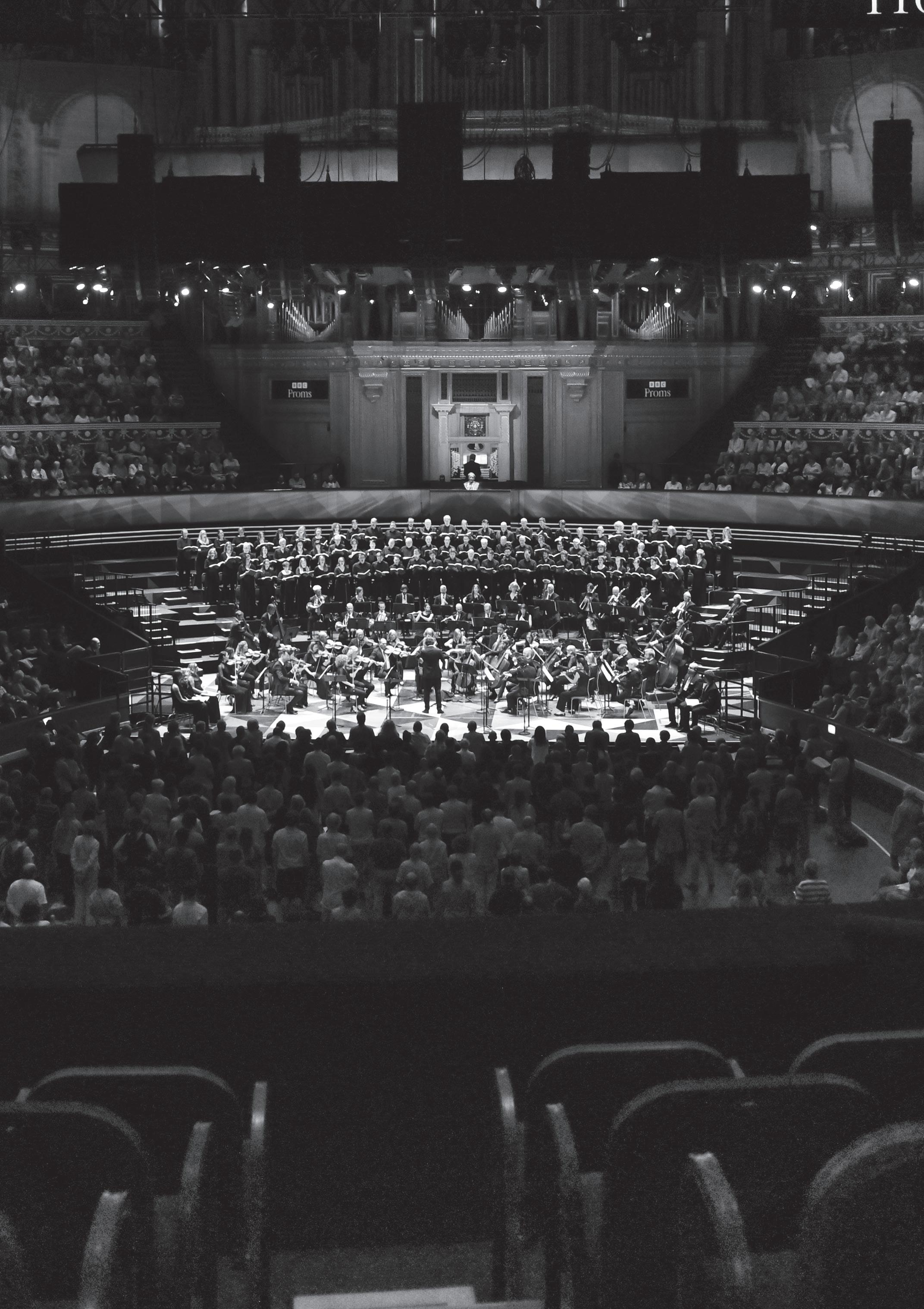
HM The King Patron
Donald MacDonald CBE
Life President
Joanna Baker CBE Chair
Gavin Reid LVO
Chief Executive
Maxim Emelyanychev
Principal Conductor
Andrew Manze
Principal Guest Conductor
Joseph Swensen
Conductor Emeritus
Gregory Batsleer
Chorus Director
Jay Capperauld
Associate Composer
Information correct at the time of going to print
First Violin
Marcus Barcham Stevens
Afonso Fesch
Alice Evans
Amira Bedrush-McDonald
Sarah Bevan Baker
Elvira van Groningen
Cheryl Crockett
Catherine James
Second Violin
Mark Derudder
Hatty Haynes
Rachel Spencer
Gongbo Jiang
Jessica Hall
Serena Whitmarsh
Viola
Hélène Clement
Francesca Gilbert
Ana Dunne Sequi
Steve King
Cello
Philip Higham
Su-a Lee
Donald Gillan
Eric de Wit
Bass
Yehor Podkolzin
Jamie Kenny
Flute
Alba Vinti López
Oboe
Kyeong Ham
Katherine Bryer
Clarinet
Maximiliano Martín
William Stafford
Bassoon
Cerys Ambrose-Evans
Alison Green
Horn
Kenneth Henderson
Daniel Lőffler
Trumpet
Peter Franks
Shaun Harrold
Timpani
Louise Lewis Goodwin
Harp
Eleanor Hudson

Marcus Barcham Stevens
Principal Second Violin
MOZART (1756-1791)
Piano Concerto No.21 in C major, K467 (1785)
Allegro maestoso
Andante
Allegro vivace assai
WEBERN (1883-1945)
Symphony, Op.21 (1927–1928)
Ruhig schreitend
Variationen
MOZART (1756-1791)
Piano Concerto No.24 in C minor, K491 (1786)
Allegro
Larghetto
Allegretto
The city of Vienna – surely the musical capital of Europe in the 18th and 19th centuries – unites the two very different composers in tonight’s concert. It was the birthplace of Anton von Webern in 1883, and the adopted home of this evening’s first composer. When Wolfgang Amadeus Mozart relocated there from his birthplace of Salzburg in 1781, Vienna was a thriving, cosmopolitan hothouse, the gleaming capital of the Habsburg Empire under the enlightened and culturally interested rule of Emperor Joseph II. It was the place to be for a young composer/teacher/pianist, and Mozart knew it.
By the time he completed tonight’s opening Piano Concerto – No.21 in C – on 9 March 1785, he was at the height of his popularity, and exceptionally busy. He’d spend his days composing and teaching – his pupils were often the less than naturally talented offspring of Vienna’s wealthiest families, sometimes to Mozart’s frustration and consternation – and his evenings would be devoted to performing or hobnobbing at some of the city’s high-class social functions. The young musician was in his element, with a new-found creative freedom (he was effectively one of the world’s first freelance composers), acclaim and adoration from Viennese audiences, and a new wife, Constanze Weber, who he married in 1782 in a union of genuine affection (despite the numerous personal and financial challenges that the couple would face).
The piano played a crucial role in Mozart’s success in Vienna. If he was going to establish himself his own terms through his own skills – rather than through the patronage of the court, church or aristocracy (and he’d had more than enough of that under the pernickety,
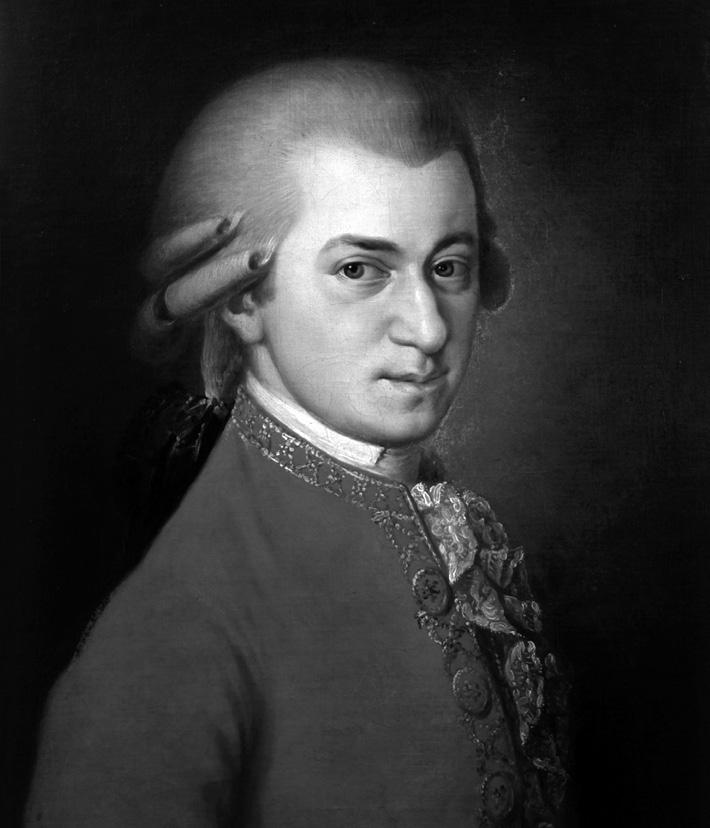
A chamber orchestra, rather than a bigger symphony orchestra, offers a balance with tonight’s soloist that’s probably closer to what Mozart himself had in mind when he wrote the piece.
controlling Prince-Archbishop Hieronymus von Colloredo, ruler of Salzburg) – he’d need more than one string to his bow. Teaching would be one of them, but he could likewise show off both his keyboard and creative skills to a broad, wealthy and discerning public through the vehicle of piano concertos, composed for himself to perform. He wrote no fewer than six in 1784 and another six in 1785. No.21 is the second from that later year, and Mozart premiered it himself at Vienna’s Burgtheater on 10 March (just a day after he’d finished writing the piece – as if more proof were needed of his hectic lifestyle). Viennese audiences lapped it up, and one critic went as far as stating that the performance ‘captivated every listener and established Mozart as the greatest keyboard player of his day’.
In that sense, Mozart was a crucial figure in the early development of the piano concerto
as a musical form, and he’d go on to influence Beethoven (especially through the second of tonight’s concertos, as we’ll see) and subsequent composers. But we should probably pause and consider terminology. It’s a moot point whether we can legitimately call these pieces ‘piano’ concertos, when the modern pianoforte – with its metal innards, its immense range and its huge, robust sonic power – wouldn’t be properly developed until the early 19th century. While Mozart was writing his concertos, the earlier harpsichord with its plucked strings was itself being superseded by the louder, more assertive fortepiano, which hit its strings with hammers – though its wooden frame and lighter action meant it had nowhere near the volume and power of the pianofortes that were to come. Why does all this matter? Well, without getting into the intricacies of arguments about historically informed performance, it at least means that a
chamber orchestra, rather than a bigger symphony orchestra, offers a balance with tonight’s soloist that’s probably closer to what Mozart himself had in mind when he wrote the piece.
There’s a sense of gleeful expectation to the strings’ quiet unisons that open the Concerto’s first movement, in a smiling, march-like theme that gradually grows in splendour and volume. A briefly stated second main theme trades questions and answers between the orchestra’s horns and higher woodwind, but the opening melody quickly returns. The music seems to slide towards slightly different emotional territory to make way for the keyboard soloist, and when they finally enter, it’s with new, quicker and more sparkling material. The central development section takes the music through some remote and colourful harmonic regions, as well as putting the soloist through their paces in some intricate keyboard writing, before the opening steals back in with very little fanfare.
The Concerto’s slow second movement is one of Mozart’s dreamiest, most enchanting creations, and was used prominently in the soundtrack to the 1967 Swedish film Elvira Madigan (the entire Concerto is occasionally referred to by that title). Details matter here in how the music conjures its distinctive mood, from the gently throbbing harmonies in the middle strings to the soft bursts of sound from the pizzicato bassline, from the piquant melody that soars high in the violins’ range to the piano’s bell-like interpretation of the same tune.
In stark contrast, Mozart’s finale is full of scampering, mischievous energy as the orchestra announces the movement’s perky main tune and the piano soloist quickly
responds. After a couple of contrasting episodes and an appropriately showy solo cadenza, the pianist drives the movement to its dazzling conclusion.
Almost exactly a century after Mozart was writing his Piano Concerto No.21, it was quite a different Vienna into which Webern was born in 1883. There were growing tensions within the centuries-old Habsburg Empire, and competing ideas about politics, freedoms, traditions and cultures across its vast territories. Vienna-born poet Stefan Zweig would later call the time a ‘golden twilight’, as the old order gave way to new and often radical ways of thinking across many public and private spheres. In visual art and architecture, the Secession movement rejected age-old tradition in favour of striking new images blending nature, eroticism and abstraction (just think of Gustav Klimt’s iconic painting The Kiss). In the still new field of psychology, Sigmund Freud was delving deep into his patients’ subconsciouses and childhood traumas to offer sometimes shocking insights into their urges, desires and neuroses. In music, too, figures such as Gustav Mahler – Director of the Vienna Court Opera from 1897 to 1907 – were pushing musical conventions to their limits in a quest for new means of expression, expanding traditional keybased tonality almost to breaking point in the process.
It was another Viennese composer – Arnold Schoenberg – who would dare to do the unthinkable and abandon traditional tonality completely, so that earlier ideas of a hierarchy of keys and tonal centres would be replaced by – well, total freedom, a sense that anything goes. And while pieces such as Pierrot lunaire and the Second String Quartet find enormous, vivid expressivity
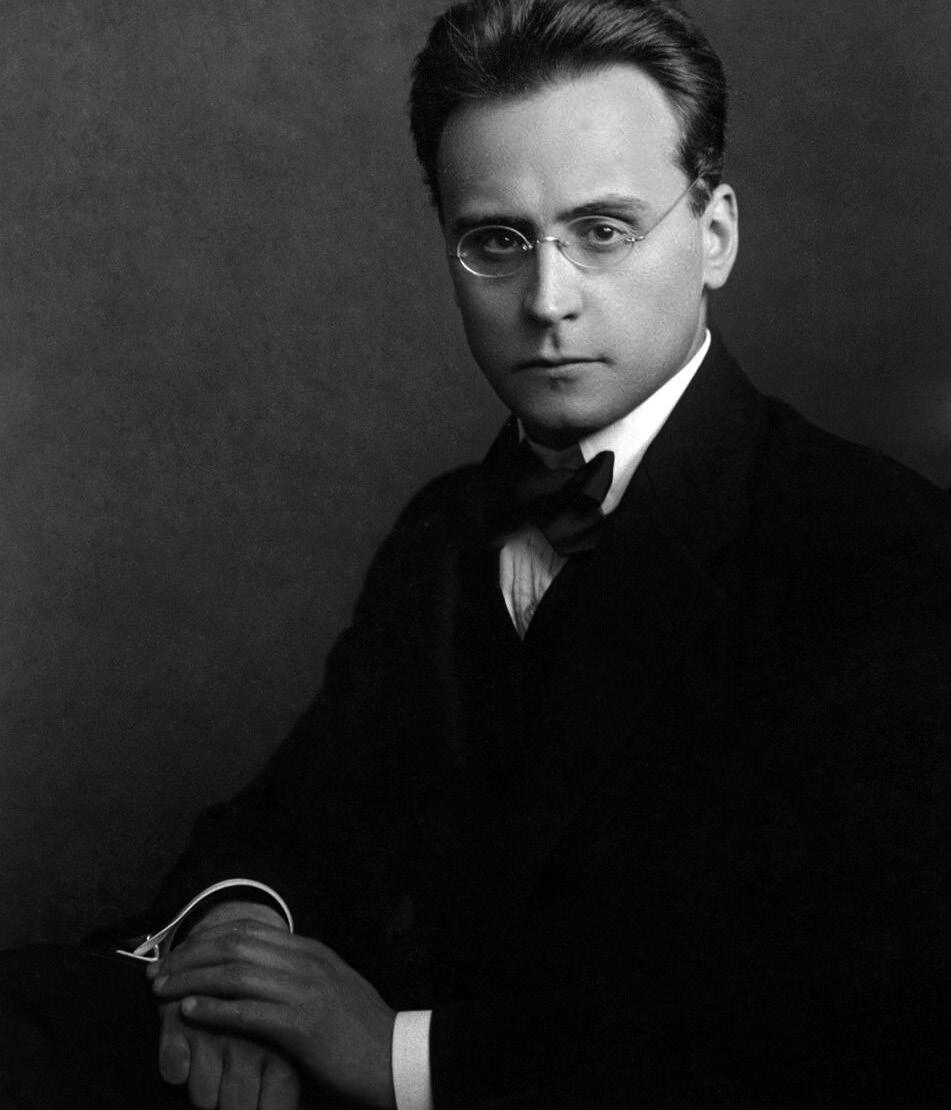
Even almost a century after its premiere, Webern’s Symphony still has the power to shock and confound listeners – with its sparse textures, its gnomic utterances, its baffling brevity.
in this new-found atonal freedom, in many ways, that very liberty was itself a problem. If anything goes, how does a composer impose control on their material, and thereby prevent it descending into chaos?
Schoenberg’s answer was an elaborate, intricate system that he devised in the early 1920s. According to its rules, a composer would begin with the 12 notes of the chromatic scale (in other words, all the white and black notes on a piano keyboard before they start to repeat), then shuffle them around into a particular order, from which new orderings might be derived by turning them backwards, upside down and putting them through many other permutations. What’s now known as serialism, or by Schoenberg as his ‘12-tone method’, was born.
Schoenberg’s most famous students –Alban Berg and Anton von Webern – took
their teacher’s ideas in very much their own directions. For Berg, that meant a deeply expressive musical language that, while never abandoning serial rigour, looked back with deep affection to the expressivity of a composer like Mahler. For Webern, it was more of a case of looking deeply into the music itself, its forms and structures, its symmetries, in a collection of bracingly brief, crystal-like works that distil the expression that another composer might have spread over half an hour into just a few, short minutes. The Symphony that Webern completed in 1928 is a perfect example.
Think of a symphony, and you might imagine a piece lasting 30-40 minutes (or possibly an hour or more with certain composers), spread across four or more movements, and probably requiring quite a large band of musicians. Webern’s is
about ten minutes long, in just two succinct movements, and uses an idiosyncratic ensemble of clarinet, bass clarinet, two horns, harp and strings (but no double basses). Even Schoenberg was astounded by the work’s concision and power. It received its premiere in New York’s Town Hall on 18 December 1929, from the Orchestra of the League of Composers conducted by Alexander Smallens, where it was met with a certain degree of bewilderment. The New York Times described it as ‘one of those whispering, clucking, picking little pieces that Webern composes, when he whittles away at small and futile ideas, until he has achieved the perfect fruition of futility’. Nonetheless, fellow musicians were fascinated, and Webern reportedly received inquiries from conductors including Otto Klemperer, Hermann Scherchen and Leopold Stokowski, who all later took the Symphony into their repertoires.
Even almost a century after its premiere, Webern’s Symphony still has the power to shock and confound listeners – with its sparse textures, its gnomic utterances, its baffling brevity. But don’t be put off.
Before the interval, tonight’s conductor Andrew Manze provides an introduction to Webern’s Symphony, shedding light on its intricacies with the help of some Orchestra members. They will then perform the work itself – a piece whose entirely expressive, musical intent surpasses any hint of it being a mathematical or intellectual exercise – to open the second half of the concert.
We return to 18th-century Vienna for tonight’s final piece, more specifically to the year after Mozart wrote the Concerto we heard earlier. He worked on his Piano
Concerto No.24 during the winter of 1785-86, and again premiered it himself in Vienna’s Burgtheater, in April 1786. It was at almost precisely the same time that Mozart was writing his opera The Marriage of Figaro, which charmed and entertained Viennese audiences with its joy and wit at its premiere on 1 May 1786 in the same venue. But if the opera is all sunny optimism and dashing, rapier humour, then the Piano Concerto No. 24 couldn’t be more different.
It's even been suggested that the two works are mismatched musical siblings – one bright, the other dark – that couldn’t exist without each other. Indeed, the Piano Concerto No.24 is one of the composer’s most daring pieces, set in a minor key from start to finish (bar its central slow movement) and seeming to delve into despair, even tragedy, despite its energy and elegance of form. It does so using the largest orchestra of any of Mozart’s keyboard concertos – bringing together strings, woodwind (including both oboes and clarinets, the only one of his piano concertos to do so), horns, trumpets and timpani – which is employed for both power and nuance throughout the piece. Beethoven was a huge fan: he famously muttered to a friend at a rehearsal of the Mozart Concerto, ‘ah, we shall never be able to do anything like that!’ It’s even been suggested that he may have modelled his own Piano Concerto No. 3, also in a tragic C minor, directly on Mozart’s earlier Concerto.
And in the light of Webern’s intricate pitch orderings, which we encountered earlier this evening, the opening theme of the Concerto’s first movement feels particularly appropriate. In it, Mozart works his way through all 12 notes of the chromatic

scale in the space of 11 bars, in a jagged, angular melody whose uncertain direction and uneven phrasing seem intentionally designed to disconcert. It’s probably no coincidence that the orchestra’s initial statement of the theme simply dies away to nothing, as if exhausted, so that when the pianist makes their first entry, it seems as if it’s with entirely new material (in fact closely related to the opening). There’s no escaping that angular theme, which lies behind almost everything heard during the movement. Yes, there are moments of brightness, but they’re made all the more poignant by the inevitable return to the movement’s opening turmoil and darkness.
The slower second movement offers respite with its brighter, more positive major key, though again the composer perhaps upsets expectations by framing it as a slow-tempo rondo with a recurring
theme (first introduced by the piano alone), traditionally the form employed for concerto finales. With a rondo finale therefore out of the question, in his final movement Mozart instead plumps for a set of variations on a somewhat brusque, minor-key opening theme. Again, the movement’s very form ensures we never escape from the theme’s seriousness and darkness, despite the creativity and inventiveness of the eight variations that Mozart spins from it. He shifts gear in the last of them into a far more lilting, dancelike rhythm, but though it might seem to offer the opportunity for a brighter, majorkey happy ending – well, Mozart is having none of it. His rhythms might be sprightlier, but the mood remains sombre, and the Concerto dashes to a resolute if despairing close.
© David Kettle

Andrew Manze is widely celebrated as one of the most stimulating and inspirational conductors of his generation. His extensive and scholarly knowledge of the repertoire, together with his boundless energy and warmth, mark him out. He held the position of Chief Conductor of the NDR Radiophilharmonie in Hannover from 2014 until 2023. Since 2018, he has been Principal Guest Conductor of the Royal Liverpool Philharmonic Orchestra. Last September he was appointed Principal Guest Conductor of the Scottish Chamber Orchestra.
In great demand as a guest conductor across the globe, Manze has long-standing relationships with many leading orchestras, including the Royal Concertgebouworkest, the Munich Philharmonic, Rotterdam Philharmonic, Royal Stockholm Philharmonic, Bamberg Symphoniker, Oslo Philharmonic, Finnish Radio, Mozarteum Orchester Salzburg, Chamber Orchestra of Europe, RSB Berlin, and the Dresden Philharmonic among others. In the 24/25 season, Manze will also make debuts with the Toronto Symphony Orchestra and the Orchestre Symphonique de Montréal, and return to the Hallé Orchestra, the Atlanta Symphony Orchestra, and the Salzburg Festival.
From 2006 to 2014, Manze was Principal Conductor and Artistic Director of the Helsingborg Symphony Orchestra. He was also Principal Guest Conductor of the Norwegian Radio Symphony Orchestra from 2008 to 2011, and held the title of Associate Guest Conductor of the BBC Scottish Symphony Orchestra for four seasons.
After reading Classics at Cambridge University, Manze studied the violin and rapidly became a leading specialist in the world of historical performance practice. He became Associate Director of the Academy of Ancient Music in 1996, and then Artistic Director of the English Concert from 2003 to 2007. As a violinist, Manze released an astonishing variety of recordings, many of them award-winning.
Manze is a Fellow of the Royal Academy of Music, Visiting Professor at the Oslo Academy, and has contributed to new editions of sonatas and concerti by Bach and Mozart, published by Bärenreiter, Breitkopf and Härtel. He also teaches, writes about, and edits music, as well as broadcasting regularly on radio and television. In November 2011 Andrew Manze received the prestigious ‘Rolf Schock Prize’ in Stockholm.
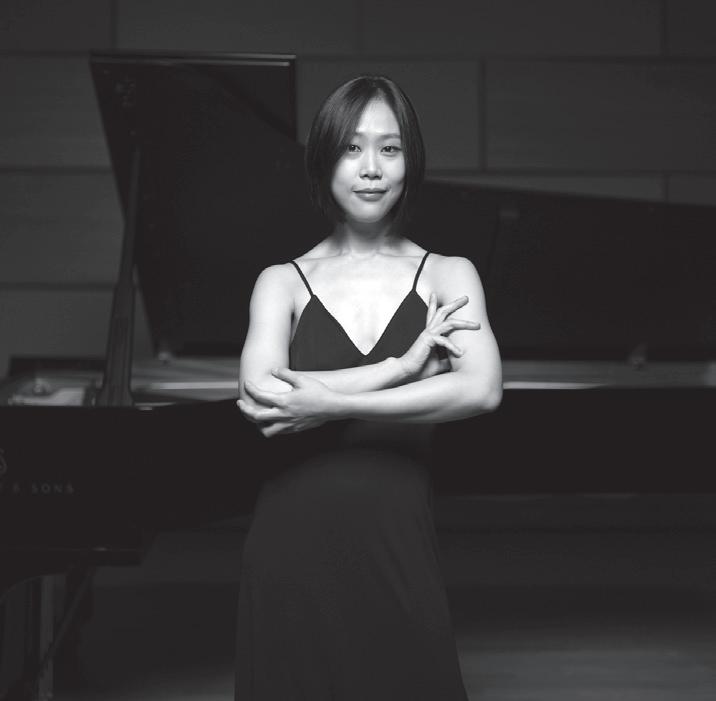
Yeol Eum Son is known for poetic elegance, expressive nuance, and electrifying contrasts in performances that span repertoire from Bach and Mozart to Shchedrin and Kapustin. Praised for her refined artistry and flawless technical control, she is in high demand worldwide as a recitalist, concerto soloist, and chamber musician, collaborating with conductors including Antonio Pappano, Roberto González-Monjas, Jonathon Heyward, Ryan Bancroft, Maxim Emelyanychev, Jaime Martín, Andrew Manze, Alexander Shelley and Omer Meir Welber.
The 2025–26 season features debuts with the Danish National, Swedish Radio, London Philharmonic, and São Paulo State Symphony Orchestras, alongside returns to the BBC Symphony, Scottish Chamber, and Singapore Symphony. In summer 2025, she made her New York orchestral debut with the Festival Orchestra of Lincoln Center and appeared at the Colorado Music Festival following a collaboration with the Colorado Symphony earlier this season.
Son’s recent North American and Canadian appearances include collaborations with the Los Angeles and Naples Philharmonics; Baltimore, Detroit, and St. Louis Symphonies; Saint Paul Chamber Orchestra; and Ottawa’s NAC Orchestra. International highlights include the London Symphony, Budapest Festival Orchestra, Dresden Philharmonic, Finnish Radio Symphony, Oslo Philharmonic, and major orchestras across Australia and New Zealand. Recent recital highlights include the Edinburgh International Festival (Scotland), Duszniki-Zdrój Chopin Festival (Poland), Mänttä Music Festival (Finland), and the Rosendal and Risør Chamber Music Festivals (Norway).
Renowned for her Mozart interpretations, Son joined the Academy of St. Martin in the Fields and Sir Neville Marriner in 2016, performing Piano Concerto No. 21 for his final recording. Her live Tchaikovsky Competition performance of the same work has been viewed nearly 23 million times on YouTube — a record for Mozart on the platform. Her Naïve recordings include Ravel: Piano Concertos – Bach/Wittgenstein, Love Music with Svetlin Roussev, and Mozart’s complete piano sonatas, as well as albums of Berg, Prokofiev, Stravinsky, and Kapustin.
Born in Wonju, South Korea, Son studied at Korea National University of Arts and with Arie Vardi in Hannover. She won silver medals at both the 2009 Van Cliburn and 2011 International Tchaikovsky Competitions.

The Scottish Chamber Orchestra (SCO) is one of Scotland’s five National Performing Companies and has been a galvanizing force in Scotland’s music scene since its inception in 1974. The SCO believes that access to world-class music is not a luxury but something that everyone should have the opportunity to participate in, helping individuals and communities everywhere to thrive. Funded by the Scottish Government, City of Edinburgh Council and a community of philanthropic supporters, the SCO has an international reputation for exceptional, idiomatic performances: from mainstream classical music to newly commissioned works, each year its wide-ranging programme of work is presented across the length and breadth of Scotland, overseas and increasingly online.
Equally at home on and off the concert stage, each one of the SCO’s highly talented and creative musicians and staff is passionate about transforming and enhancing lives through the power of music. The SCO’s Creative Learning programme engages people of all ages and backgrounds with a diverse range of projects, concerts, participatory workshops and resources. The SCO’s current five-year Residency in Edinburgh’s Craigmillar builds on the area’s extraordinary history of Community Arts, connecting the local community with a national cultural resource.
An exciting new chapter for the SCO began in September 2019 with the arrival of dynamic young conductor Maxim Emelyanychev as the Orchestra’s Principal Conductor. His tenure has recently been extended until 2028. The SCO and Emelyanychev released their first album together (Linn Records) in 2019 to widespread critical acclaim. Their second recording together, of Mendelssohn symphonies, was released in 2023, with Schubert Symphonies Nos 5 and 8 following in 2024.
The SCO also has long-standing associations with many eminent guest conductors and directors including Principal Guest Conductor Andrew Manze, Pekka Kuusisto, François Leleux, Nicola Benedetti, Isabelle van Keulen, Anthony Marwood, Richard Egarr, Mark Wigglesworth, Lorenza Borrani and Conductor Emeritus Joseph Swensen.
The Orchestra’s current Associate Composer is Jay Capperauld. The SCO enjoys close relationships with numerous leading composers and has commissioned around 200 new works, including pieces by Sir James MacMillan, Anna Clyne, Sally Beamish, Martin Suckling, Einojuhani Rautavaara, Karin Rehnqvist, Mark-Anthony Turnage, Nico Muhly and the late Peter Maxwell Davies.
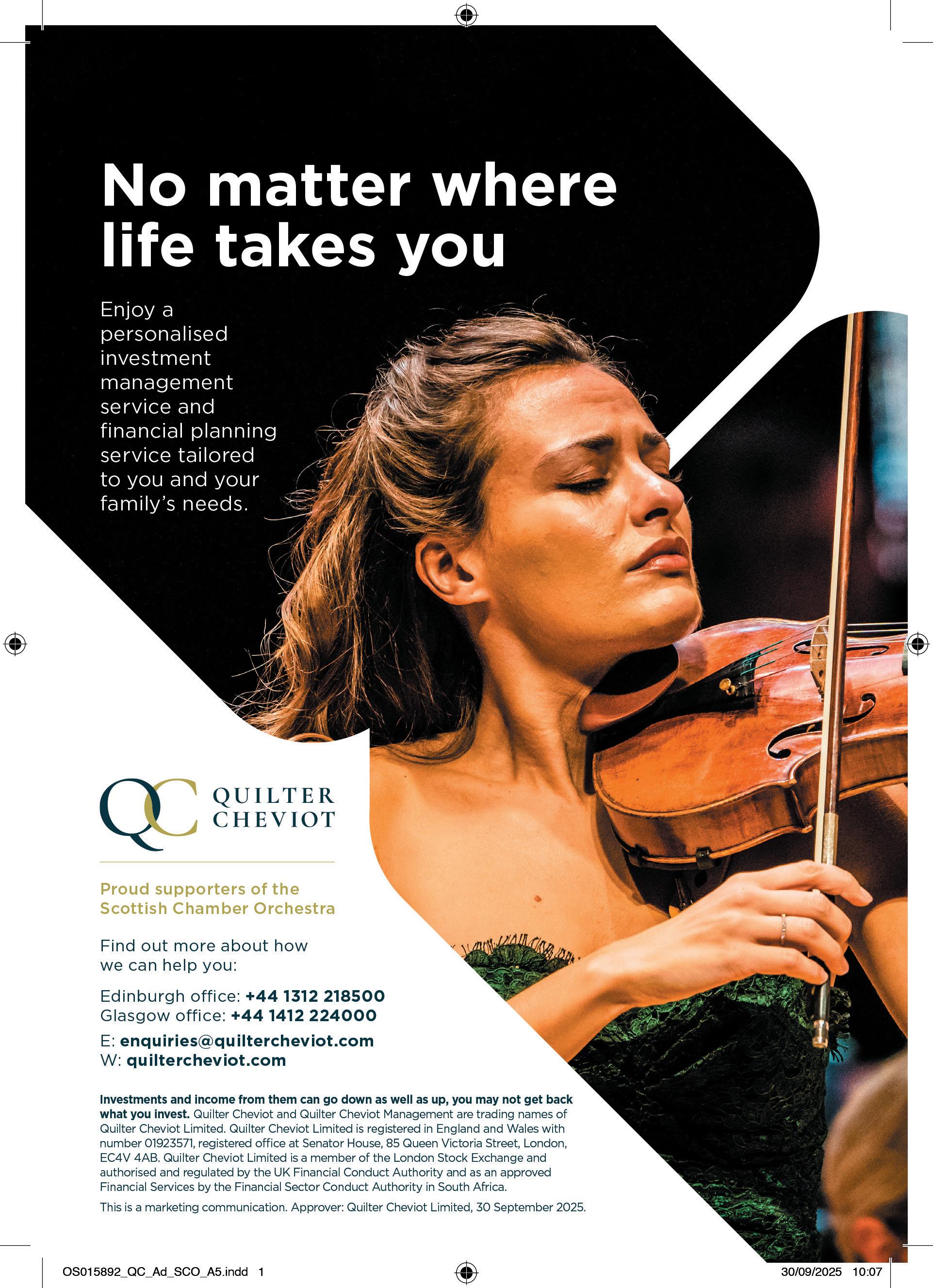


Each year, the SCO must fundraise around £1.2 million to bring extraordinary musical performances to the stage and support groundbreaking education and community initiatives beyond it.
If you share our passion for transforming lives through the power of music and want to be part of our ongoing success, we invite you to join our community of regular donors. Your support, no matter the size, has a profound impact on our work – and as a donor, you’ll enjoy an even closer connection to the Orchestra.
To learn more and support the SCO from as little as £5 per month, please contact Hannah at hannah.wilkinson@sco.org.uk or call 0131 478 8364.
SCO is a charity registered in Scotland No SC015039.